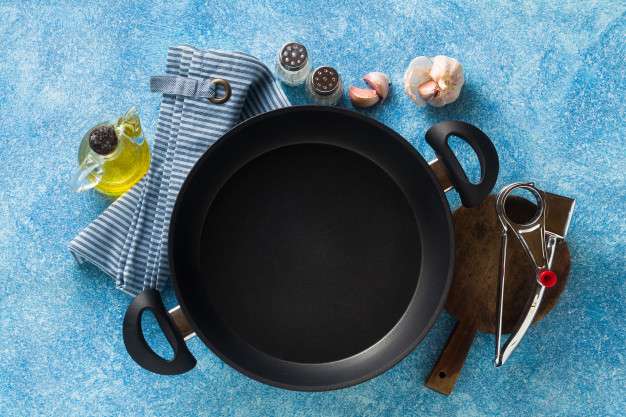The advent of nonstick cookware was somewhat of an accident. In 1938, research chemist Roy Plunkett was experimenting with alternatives to the refrigerant Freon for the DuPont chemical company. One of his experiments involved freezing and compressing tetrafluoroethylene, a colorless, odorless gas; the gas transformed into a white, waxy solid. Dubbed polytetrafluoroethylene, or PTFE, this unique solid had an extremely low coefficient of friction. DuPont trademarked PTFE as Teflon, and 20 years later it became the primary component of nonstick cookware.
If you could magnify a metal pan, you would see that its surface is rugged and covered with thousands of microscopic nooks and crannies. When heated, the metal expands and these pores enlarge, allowing food to seep in, solidify, and stick. To minimize that sticking tendency, you can coat a metal pan with oil, which fills the metal’s fissures so that food can’t enter (that’s what you do when you season a cast-iron skillet), or you can use a pan that has been industrially coated with a nonstick material like PTFE, which fills the pores of the pan, making it is surface smooth and virtually nonstick.
Here’s how to extend the useful life of your nonstick cookware.
• Before the first use, gently hand wash the pan to remove any dust and debris.
• Refrain from using cooking sprays containing lecithin, which may leave a gummy residue on the pan. Lubricate the pan with a light coating of oil instead.
• Don’t heat the pan above 500°F (medium to medium-high heat, depending on your stove). Avoid drastic or sudden changes in temperature, which will weaken the nonstick material. This includes running a hot pan under cold water to cool it down.
• Don’t heat empty nonstick pans.
• To prevent scratching, use plastic, rubber, silicone, or wooden utensils, and avoid anything sharp.
• Gently hand wash nonstick cookware instead of using the dishwasher. Avoid abrasive cleaners, steel wool, and steel scouring pads. To remove stubborn debris, put enough water in the pan to come halfway up the sides, boil the water for 5 minutes, and then wash. Or soak the pan in a solution of 1 cup water to 1 Tbs.
Gently hand wash nonstick cookware instead of using the dishwasher. Avoid abrasive cleaners, steel wool, and steel scouring pads. To remove stubborn debris, put enough water in the pan to come halfway up the sides, boil the water for 5 minutes, and then wash. Or soak the pan in a solution of 1 cup water to 1 Tbs. dishwashing liquid.
• Hang pans side by side instead of stacking them, which can scratch the nonstick surface.
• Replace nonstick cookware when food sticks to it or when the pan shows signs of excessive scratching, blistering, peeling, flaking, or chipping.
Nonstick cookware is safe to cook in, easy, convenient, and durable. A good non-stick range should be part of every kitchen along with that traditional cast-iron skillet.


Wpbingo
Lorem ipsum dolor sit amet, consectetur adipiscing elit. Nam fringilla augue nec est tristique auctor. Donec non est at libero vulputate rutrum. Morbi ornare lectus quis justo gravida semper. Nulla tellus mi, vulputate adipiscing cursus eu, suscipit id nulla.
Wpbingo
Lorem ipsum dolor sit amet, consectetur adipiscing elit. Nam fringilla augue nec est tristique auctor. Donec non est at libero vulputate rutrum. Morbi ornare lectus quis justo gravida semper. Nulla tellus mi, vulputate adipiscing cursus eu, suscipit id nulla.
Wpbingo
Lorem ipsum dolor sit amet, consectetur adipiscing elit. Nam fringilla augue nec est tristique auctor. Donec non est at libero vulputate rutrum. Morbi ornare lectus quis justo gravida semper. Nulla tellus mi, vulputate adipiscing cursus eu, suscipit id nulla
Wpbingo
Lorem ipsum dolor sit amet, consectetur adipiscing elit. Nam fringilla augue nec est tristique auctor. Donec non est at libero vulputate rutrum. Morbi ornare lectus quis justo gravida semper. Nulla tellus mi, vulputate adipiscing cursus eu, suscipit id nulla.